机器学习算法--Perceptron(感知器)算法
概括
Perceptron(感知器)是一个二分类线性模型,其输入的是特征向量,输出的是类别。Perceptron的作用即将数据分成正负两类的超平面。可以说是机器学习中最基本的分类器。
模型
Perceptron 一样属于线性分类器。
对于向量\(X={x}_1,{x}_2,...{x}_n\),对于权重向量(w)相乘,加上偏移(b),于是有:
设置阈值threshold之后,可以的到
即,可以把其表示为:
参数学习
我们已经知道模型是什么样,也知道Preceptron有两个参数,那么如何更新这两个参数呢?
首先,我们先Preceptron的更新策略:
-
初始化参数
-
对所有数据进行判断,超平面是否可以把正实例点和负实例点完成正确分开。
-
如果不行,更新w,b。
-
重复执行2,3步,直到数据被分开,或者迭代次数到达上限。
那么如何更新w,b呢?
我们知道在任何时候,学习是朝着损失最小的地方,也就是说,我的下一步更新的策略是使当前点到超平面的损失函数极小化。
在超平面中,我们定义一个点到超平面的距离为:(具体如何得出,可以自行百度~~~ ),此外其中$ \frac{1}{\left | \mathbf{w} \right |}$是L2范数。意思可表示全部w向量的平方和的开方。
这里假设有M个点是误差点,那么损失函数可以是:
当然,为了简便计算,这里忽略$ \frac{1}{\left | \mathbf{w} \right |}$。
-
$ \frac{1}{\left | \mathbf{w} \right |}$不影响-y(w,x+b)正负的判断,即不影响学习算法的中间过程。
-
因为感知机学习算法最终的终止条件是所有的输入都被正确分类,即不存在误分类的点。则此时损失函数为0,则可以看出$ \frac{1}{\left | \mathbf{w} \right |}$对最终结果也无影响。
-
既然没有影响,为了简便计算,直接忽略$ \frac{1}{\left | \mathbf{w} \right |}$。
- 这里可以把损失函数表示为:
这里我们只对一个点到超平面的损失进行计算。利用\(L(\mathbf{w},\mathbf{b})\)分别对w跟b求导,可得使L最小的w,b:
那么对于w,b的更新可以表示为:
注意
对于线性可分的数据,Perceptron在有限的迭代里一定会找到一个超平面,可以把数据正确分类,但是这个分离超平面不是唯一的。
对于线性不可分数据,Perceptron学习算法永远不会结束,只可能达到迭代次数,因为不存在超平面完美分类数据,学习后期的超平面会一直“震荡”。
验证及代码
首先生成一组数据,可以完美线性可分
import matplotlib.pyplot as plt
import numpy as np
%matplotlib inline
# generate the separable data
def generate_separable_data(N):
np.random.seed(2333) # for reproducibility
w = np.random.uniform(-1, 1, 2)
b = np.random.uniform(-1, 1)
X = np.random.uniform(-1, 1, [N, 2])
y = np.sign(np.inner(w, X)+b)
return X,y,w,b
# generate the non separable data, set the first negative point as the positive point.
def generate_non_separable_data(N):
np.random.seed(2333) # for reproducibility
w = np.random.uniform(-1, 1, 2)
b = np.random.uniform(-1, 1)
X = np.random.uniform(-1, 1, [N, 2])
y = np.sign(np.inner(w, X)+b)
for i in range(len(y)):
if y[i] == -1:
y[i] = 1
break
return X,y,w,b
#plot the data
def plot_data(X, y, w, b) :
fig = plt.figure(figsize=(4,4))
plt.xlim(-1,1)
plt.ylim(-1,1)
a = -w[0]/w[1]
pts = np.linspace(-1,1)
plt.plot(pts, a*pts-(b/w[1]), 'k-')
cols = {1: 'r', -1: 'b'}
for i in range(len(X)):
plt.plot(X[i][0], X[i][1], cols[y[i]]+'o')
plt.show()
X,y,w,b = generate_separable_data(50)
plot_data(X, y, w,b)

X,y,w,b = generate_non_separable_data(50)
plot_data(X, y, w,b)
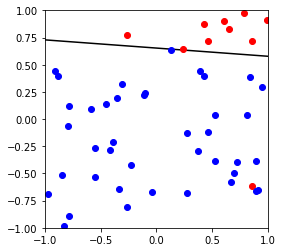
The Perceptron
class Perceptron :
"""An implementation of the perceptron algorithm."""
def __init__(self, max_iterations=100, learning_rate=0.2) :
self.max_iterations = max_iterations
self.learning_rate = learning_rate
def fit(self, X, y) :
X = self.add_bias(X,y)
self.w = np.zeros(len(X[0]))
converged = False
iterations = 0
while (not converged and iterations <= self.max_iterations) :
converged = True
for i in range(len(X)) :
if y[i] * self.decision_function(X[i]) <= 0 :
self.w = self.w + y[i] * self.learning_rate * X[i]
converged = False
iterations += 1
self.converged = converged
plot_data(X[:,1:], y, self.w[1:],self.w[0])
if converged :
print ('converged in %d iterations ' % iterations)
else:
print ('cannot converged in %d iterations ' % iterations)
print ('weight vector: ' + str(self.w))
def decision_function(self, x) :
return np.inner(self.w, x)
def predict(self, X) :
scores = np.inner(self.w, X)
return np.sign(scores)
def add_bias(self,X,y):
a = np.ones(X.shape[0])
X = np.insert(X, 0, values=a, axis=1)
return X
def error(self,X,y):
num = 0
err_sco = self.predict(X)
num =sum (err_sco!=y)
return num/len(X)
测试可以分割的数据
X,y,w,b = generate_separable_data(100)
p = Perceptron()
p.fit(X,y)

converged in 41 iterations
weight vector: [-1. 0.07009608 1.53050105]
The Pocket
一种优化后的Perceptron。
Pocket 与Perceptron的参数更新一致,但是pocket在一定程度上解决了Perceptron震荡的问题。
- 在Perceptron中,碰到无法完美分割的数据集,只能等迭代次数到达上限,至于结果,无法预知,可能较好,可能很差,取决于震荡的结果。
- 而在Pocket中,我们加入了最优参数的记录,保证记录的参数是最好的,那么即使不能完美分割数据,也可以得到最优的解。
我们来看一下Pocket的更新策略:
- 初始化参数,记录为最优
- 对所有数据进行判断,超平面是否可以把正实例点和负实例点完成正确分开。
- 如果不行,计算最优w_p,b_p 下的误差值e_p,w,b下的误差值e,对比e_p与e。
- 如果新w,b产生的误差值(e<e_p)小,令w_p = w,b_p = b,否则w_p,b_p不变
- 更新w,b
- 重复执行2,3,4,5步,直到数据被分开,或者迭代次数到达上限。
import copy
class Pocket :
"""An implementation of the Pocket algorithm."""
def __init__(self, max_iterations=100, learning_rate=0.2) :
self.max_iterations = max_iterations
self.learning_rate = learning_rate
def fit(self, X, y) :
X = self.add_bias(X,y)
self.w = np.zeros(len(X[0]))
self.w_p = np.zeros(len(X[0])) # the best w
self.error_pocket = self.error(X,y)
converged = False
iterations = 0
while (not converged and iterations <= self.max_iterations) :
converged = True
for i in range(len(X)) :
if y[i] * self.decision_function(X[i]) <= 0 :
self.w = self.w + y[i] * self.learning_rate * X[i]
"""if self.w makes fewer mistakes than self.w_p, replace the
self.w_p by self.w
In this way, it can find a "(somewhat)best" weight
"""
self.error_in = self.error(X,y)
### save the best value of w and b
if self.error_pocket>self.error_in:
self.w_p = copy.copy(self.w)
self.error_pocket = copy.copy(self.error_in)
converged = False
iterations += 1
self.converged = converged
self.w = self.w_p
plot_data(X[:,1:], y, self.w[1:],self.w[0])
if converged :
print ('converged in %d iterations ' % iterations)
else:
print ('cannot converged in %d iterations ' % iterations)
print ('weight vector: ' + str(self.w))
def decision_function(self, x) :
return np.inner(self.w, x)
def predict(self, X) :
scores = np.inner(self.w, X)
return np.sign(scores)
def add_bias(self,X,y):
a = np.ones(X.shape[0])
X = np.insert(X, 0, values=a, axis=1)
return X
def error(self,X,y):
num = 0
err_sco = self.predict(X)
num =sum (err_sco!=y)
return num/len(X)
测试可以分割的数据
X,y,w,b = generate_separable_data(100)
p = Pocket()
p.fit(X,y)
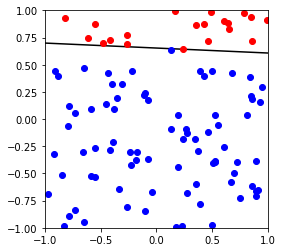
converged in 41 iterations
weight vector: [-1. 0.07009608 1.53050105]
对比
对比Perceptron 跟pocket的具体区别,这里使用不可分割数据作为测试查看
下图可以看出,Perceptron不能很好的针对不可分做出优化,而pocket由于保存了较好的模型,理论上如果迭代次数足够,可以达到最优模型
Perceptron
X,y,w,b = generate_non_separable_data(100)
p = Perceptron()
p.fit(X,y)
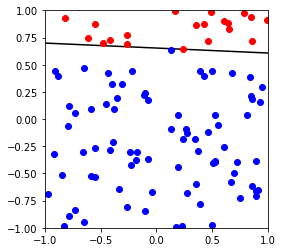
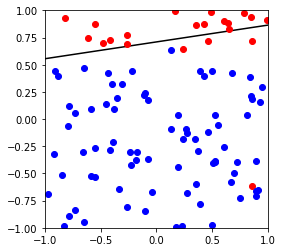
cannot converged in 101 iterations
weight vector: [-0.4 -0.08723007 0.56359207]
X,y,w,b = generate_non_separable_data(100)
p = Pocket()
p.fit(X,y)
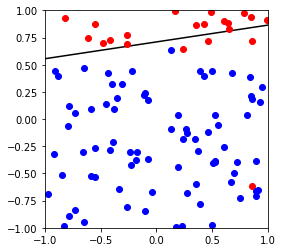
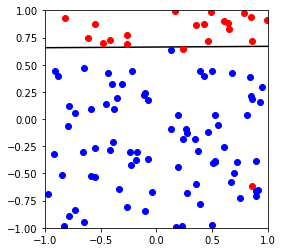
cannot converged in 101 iterations
weight vector: [-0.4 -0.00380026 0.60356631]


 浙公网安备 33010602011771号
浙公网安备 33010602011771号